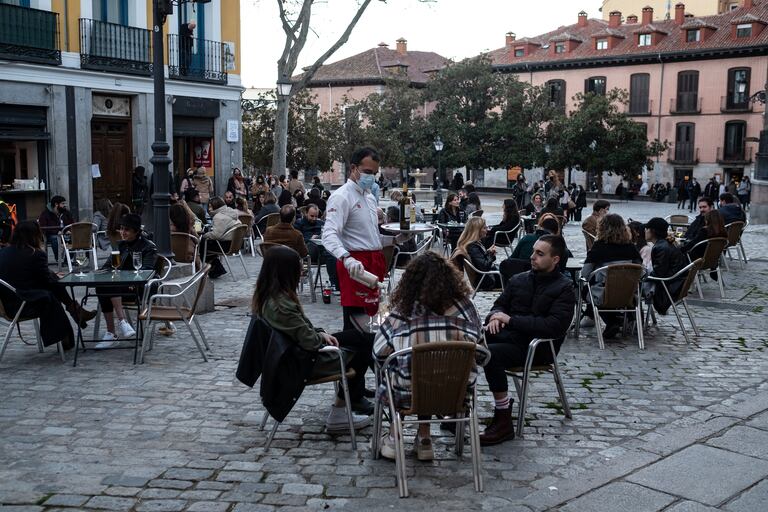Atmosphere on terraces in the center of Madrid on February 13. David G. Folgueiras
Note to readers: EL PAÍS
openly
offers
essential information on
the coronavirus during the crisis.
If you want to support our journalism,
subscribe here
.
Coronavirus infections continue to fall in Spain, but the country is still far from keeping the pandemic at bay.
The peak of the third wave has already passed and, although new infections and hospital admissions are falling, the pressure on care keeps hospitals in check: 3,822 people remain in intensive care.
The Ministry of Health has reported 14,515 new cases and 388 deaths this Thursday and the accumulated incidence is still at very high levels: 321 cases per 100,000 inhabitants.
The director of the Center for the Coordination of Health Alerts and Emergencies, Fernando Simón, has asked not to lower his guard, but some communities are already making progress in their de-escalation plan.
From this Thursday, the Community of Madrid delays the start of the curfew for one hour, at 11:00 p.m. and allows bars to open until that time (before they closed at 9:00 p.m.).
Castilla y León, meanwhile, will lift the perimeter closure by provinces and Aragón will deconfine the perimeter of the cities of Zaragoza and Calatayud.
Experts ask not to rush into the de-escalation and warn of the progression of the British variant of the virus, more contagious.
Coronavirus in Spain: these are the new restrictions by autonomous communities
Although the trend of the epidemic curve is good, Spain is still on high alert and far from being able to control the transmission of the virus.
In fact, the incidence of infections is well above the extreme risk threshold stipulated by Health (250 cases per 100,000 inhabitants).
Only seven communities (the Canary Islands, Cantabria, the Balearic Islands, Extremadura, Murcia, Navarra and La Rioja) are below this level, but Simón has warned that even this incidence figure is “very bad”.
Hospital pressure also persists with 35% of intensive care units (ICU) occupied by patients with covid.
"They are still very high figures that prevent us from softening the measures more than necessary because if there is a regrowth, the occupancy level will be excessive for the system to withstand it", Simón assured.
Communities have faced the third wave in a heterogeneous way, with disparate measures.
And not necessarily the most threatened were the most forceful.
Navarra, with just over 400 cases per 100,000 inhabitants, closed the interior of the bars on January 23, while Madrid, which then doubled the incidence, kept them open (the interior at 50% and the exterior, at 75 %).
"In the third wave we have descended very quickly, but it is also true that it has done more in the communities in which the toughest measures have been taken", confirmed the Minister of Health, Carolina Darias, during the Health Commission in The congress.
Darias has called for extreme precautions to reach the goal of reaching an incidence below 50 cases per 100,000 inhabitants, the threshold stipulated by Health to keep the epidemic at bay.
“We have to be very cautious and the cumulative incidence is above the maximum risk level.
We must maintain the restrictive measures, we cannot lower our guard, we have variants on the horizon and I ask that the measures be maintained in all the autonomous communities ”, he claimed.
However, the communities have assumed the fall in infections as an incentive to start de-escalating the restrictions and, to a greater or lesser extent, have begun to modulate their restrictions.
Madrid, which already had the lightest measures despite the high incidence that has dragged on for weeks (it touched 1,000 cases per 100,000 inhabitants at the end of January), has been one of the first autonomies to ease restrictions and two weeks ago it extended from four to six the maximum number of people who could meet on the terraces of the bars.
Although it is still the community with the highest incidence (457 cases per 100,000, only behind the autonomous city of Melilla), since this Thursday, it also delays the curfew and gives air to the hotel industry with two more hours of night activity .
"Communities such as Madrid, Extremadura or Castilla-La Mancha are opting for the path of relaxation and make a fatal mistake because this will result in an intensification of transmission, a slowdown in the fall of the curve and a maintenance of healthcare pressure" , values Daniel López-Acuña, former Director of Emergencies of the World Health Organization (WHO).
Castilla-La Mancha (275 cases per 100,000 inhabitants) lifted the perimeter closure of provinces and municipalities last Friday and reopened the hotel business, which was closed.
Extremadura, for its part, has reopened bars with limited capacity and shopping centers and, as of this Friday, it will also suspend the perimeter closure between municipalities.
There are other communities that applied tougher restrictions, almost like a kind of confinement, and have also begun to lift measures.
This is the case of La Rioja which, as of Monday, will lift the perimeter closure and the non-essential activity, which was suspended, will resume.
Galicia, for its part, has also announced a gradual de-escalation and, for now, the trade will be able to open until 9:00 p.m. (before it closed at 6:00 p.m.), although the hotel industry will remain closed.
“We are in that very dangerous phase that we are already experiencing at the end of November: thinking that, as the trend is good, the situation is good.
And that is not like that.
By confusing the two, the pressures to accelerate the de-escalation are going to be enormous and are going to take place in the next two weeks, which are key to seeing what happens with the British variant.
It is a delicate moment, especially if we let ourselves be carried away by joy ”, Alberto Infante tertia, emeritus professor of International Health at the National School of Health of the Carlos III Health Institute.
The progression of the British variant of the virus, of which 613 cases have been confirmed in Spain, may reverse the trend and, with hospitals still very stressed, put the entire health system in check again.
“In December, the Constitution bridge and the Black Friday sales were enough for the curve to change the trend.
And that at the time we did not have the threat of the British variant and the incidents were 190 cases per 100,000, while now they are 300 ″, Infante alerts.
The real presence of the British variant in Spain is still unknown with certainty, but Health estimates that it is already behind 20% of infections and may play an important role in a possible rebound in the epidemic curve.
“We are seeing it in Catalonia.
By introducing a higher contagiousness, we can slow down the downward curve, ”says López-Acuña.
Precisely, due to the slowdown in the fall of infections in recent days, the Generalitat is considering slowing down its de-escalation plan.
"Surely, the variant will be more widespread, we just don't know how much, how it grows and where it is most installed.
With this variant we continue blindly.
They should have installed a system of sentinel posts in charge of measuring their progress, ”Infante claims.
Uncontrolled masks on the terraces and inside the bars: “Madrid is paradise”
Experts warn that neither vaccination - one million people have completed the schedule - has reached a sufficient number of immunized to be reflected in the epidemic curve.
Only in residences, where outbreaks have fallen by half in 15 days and communities report a reduction in infections and serious illness, are the effects beginning to be seen.
“You have to be cautious for four or six weeks.
If the number of patients in the ICU does not improve substantially, it would be appropriate not to lower the restrictions.
If we manage to vaccinate more than 15% of the population we could begin to lift mobility restrictions, but now we are far from a minimum protection ”, points out Benito Almirante, head of Infectious Diseases at the Vall d'Hebron Hospital in Barcelona.
Above all, the epidemiologists consulted insist, the transmission of the virus in Spain is still too high and that translates into many admissions and deaths.
“We have normalized the tragedy.
We take for good figures of 300 deaths because we have had 700, but it is not normal.
And what we will see next may not be a very large regrowth, but it will be maintained over time and will not finish lowering.
And that translates into more deaths, ”Infante warns.




/cloudfront-eu-central-1.images.arcpublishing.com/prisa/FNKLLK5XKNWEKUJYBF4ZFC5S6U.jpg)
/cloudfront-eu-central-1.images.arcpublishing.com/prisa/JNAMK37HFIZKML76SWBTDTD3QI.jpg)



